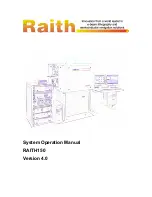
Operating
lnstructlons-5110
A
thermal cutout
in
the display module provides
thermal
protection and disconnects the power to
the
instrument
if the internal temperature exceeds
a
safe
operating
level.
This
device will automatically re-apply
power when
the
temperature returns to
a safe level.
PLUG-IN
UNITS
The
oscilloscope
is
designed
to accept up to
three
Tektronix
5000-series
plug-in units (use
only "N" suffix
plug-in
units
unless otherwise specified). This plug-in
feature allows a
variety of display combinations
and also
allows
selection of bandwidth, sensitivity, display
mode,
etc.,
to meet
the measurement
requirements. In addition, it
allows the oscilloscope system to
be expanded to meet
future measurement requirements.
The
overall
capabilities of
the
resultant system are
in large part
determined by
the
characteristics oftheplug-insselected.
Installation
To
install
a
plug-in unit into one or the
plug-in
compartments,
align
the
slots in the
top and bottom of the
plug-in
with the associated
guides in the plug-in compart
ment.
Push the plug-in unit firmly into the plug-in
compartment
until
it locks
into place.
To
remove
a plug-in,
pull
the
release latch on the plug-in unit to disengage it
and
puli the unit out of the plug-in compartment. Plug-in
units should
not be removed or installed without turning
off
the instrument
power. It is not necessary that all of the
plug-in
compartments
be filled to operate the instrument,
the
only
plug-ins needed are those required for the
measurement to
be
made.
When the
oscilloscope is adjusted in accordance with
the adjustment procedure
given in this manual, the vertical
and
horizontal gain are
standardized. This allows
adjusted
plug-in
units
to be changed
from one plug-in compart
ment
to
another
without readjustment. However, the basic
adjustment
of
the
individual plug-in units should be
checked
when
they are installed
in this system to verify
their
measurement
accuracy.
See the plug-in unit manual
for
verification
procedure.
Selection
The
plug-in versatility of the oscilloscope allows a
variety of display modes with many
different plug-ins. The
following
information is provided here to aid in plug-in
selection.
NOTE
Use
only "N" suffix plug-in units with the os
cilloscope unless otherwise
specified.
To
produce
a single-trace
display, install a single
channel
vertical
unit (or
dual-channel unit set
for single
channel
operation) in
either of
the vertical (left or center)
compartments and
a
time-base unit in the horizontal
(right) compartment. For dual-trace
displays, eitherinstall
a
dual-channel vertical
unit in one of the vertical com
partments
or
install a single-channel vertical unit in
each
vertical
compartment. A combination
of a single-channel
and
a dual-channel vertical
unit allows a three-trace
display;
likewise, a combination of
two dual-channel
vertical
units allows a four-trace display.
To
obtain
a
vertical sweep with the input signal
displayed
horizontally,
insert the time-base unit into one
of the vertical compartments and
the amplifier unit in the
horizontal
compartment. If
a vertical sweep is used, there
is no
retrace blanking; however, if
used in the right vertical
(center)
compartment, internal triggering is provided.
For X-Y displays, either a 5A-series
amplifier unit ora
5B-series time-base unit
having
an amplifier channel can
be installed
in the horizontal compartment to accept the
X
signal.
The Y signal is connected to a 5A-series amplifier
unit installed in a vertical compartment.
Special
purpose plug-in
units may
have specific restric
tions regarding the compartments
in which they can be
installed. This
information will
be given in the instruction
manuals
for
these plug-ins.
CONTROLS
AND
CONNECTORS
Controls and
connectors necessary
for operation of
the
oscilloscope
are located
on
the front and rear panels of the
instrument.
To make full
use of the capabilities of this
instrument,
the operator
should
be familiar with the
function and use of each external control
and connector.
A brief description of the controls and connectors is given
here.
More detailed information is given under General
Operating
Information (later in this section). See Fig.
1-2
for
the
location and description of the controls and
connectors.
FIRST
TIME
OPERATION
The
following
procedure provides an operational
checkout
as
a means of verifying instrument operation
and
basic calibration
without removing the cabinet or
making internal
adjustments. Since
it demonstrates the
use of front-panel controls and connectors, it can
also be
used
to
provide basic training on the operation of this
instrument. If recalibration of the oscilloscope or plug-ins
appears
to be
necessary,
refer the instrument system to
qualified service personnel.
If more familiarization with a
plug-in
unit is needed, see the instruction manual for the
appropriate
plug-in unit. Refer to Fig.
1-2
for the os
cilloscope
control
and
connector locations.
1-2
Summary of Contents for 5110
Page 6: ...5110 Fig 1 1 5110 Oscilloscope 2134 01 ...
Page 22: ......
Page 34: ......
Page 42: ......
Page 83: ...5110 I43XII3 2134 15 ...
Page 84: ... i 143 I132 2134 15 BLOCK DIAGRAM ...
Page 85: ... t 2 E I 5110 S LNHNOdWOD BOVJHaiNI ...
Page 88: ...J4 O3 INTERFACE J INTERFACE A NOV 1978 ...
Page 92: ...AUXILIARY BOARD 1143 2134 18 AUXILIARY BOARD ...
Page 95: ...DEFLECTION AMPLIFIERs ...
Page 102: ...LV POWERSUPPLY CALIB COMPONENTS A 4 L V Power Supply circuit board 5110 ...
Page 107: ...SIGNALS OUT OPTION 7 ONLY SI 10 OPT 7 213 26 REV A FE BI979 SIGNALS OUT COPTION T ONLY n ...
Page 114: ......
Page 115: ...5110 OSCILLOSCOPE ...
Page 116: ...FIG 2 MAINFRAME p 5110 OSCILLOSCOPE ...
Page 117: ...1 ...
Page 121: ...o ...
Page 122: ...S 1 5110 OSCILLOSCOPE ...
Page 123: ...13 FIG 4 RACKMOUNT CABINET 5110 OSCILLOSCOPE ...
Page 124: ......









































